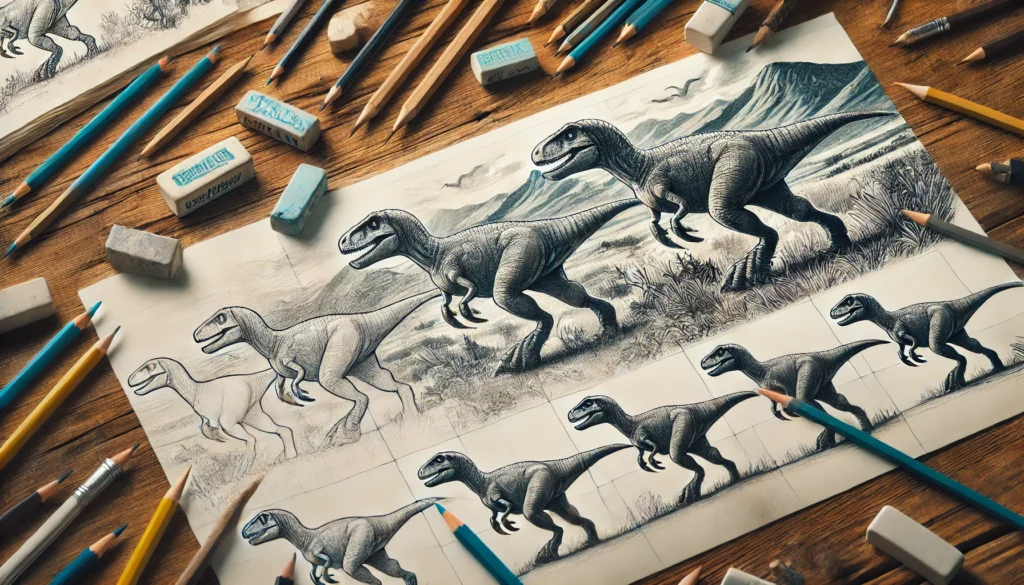drawing:sdn2sx5y0y0= dinosaur is a fun and imaginative way to bring the ancient world back to life. From fierce carnivores like the T-Rex to gentle giants like the Brachiosaurus, dinosaurs offer a variety of shapes and textures to explore. Whether you’re a beginner or a seasoned artist, learning to draw dinosaurs can develop your skills and inspire creativity.
Table of Contents
When exploring the concept of “drawing:sdn2sx5y0y0= dinosaur,” it’s important to start with the basics. Dinosaur drawing involves understanding the unique anatomy of these creatures and experimenting with different art techniques to create realistic illustrations. By following this guide, you’ll gain knowledge on essential drawing techniques, discover tips for avoiding common mistakes, and learn how to add detail and texture to make your artwork stand out.
Selecting the Type of drawing:sdn2sx5y0y0= dinosaur to Draw
Choosing which dinosaur to draw is an exciting first step. drawing:sdn2sx5y0y0= dinosaur come in all shapes and sizes, each with distinct characteristics that can influence your artistic approach. For example, if you’re interested in drawing fierce carnivores, the Tyrannosaurus Rex is a popular choice with its massive jaws and sharp teeth. On the other hand, if you prefer gentle herbivores, a Brachiosaurus with its long neck and large, sturdy legs might be more appealing.
Another factor to consider is the dinosaur’s posture and physical build. Some dinosaurs, like the Velociraptor, have a sleek, bird-like body that’s built for speed, while others, such as the Triceratops, have bulky bodies and distinct facial features like horns and a frilled crest. Selecting a drawing:sdn2sx5y0y0= dinosaurthat matches your skill level and preferred drawing style can make the experience more enjoyable and rewarding.
Tips for Choosing a drawing:sdn2sx5y0y0= dinosaur
- Consider Your Skill Level: If you’re a beginner, try starting with simpler shapes, like the Stegosaurus. For advanced artists, a more intricate drawing:sdn2sx5y0y0= dinosaur like the Spinosaurus, can provide a good challenge.
- Think About Unique Features: drawing:sdn2sx5y0y0= dinosaur like the Pterodactyl offer the chance to draw wings, while others, like the Ankylosaurus, have interesting textures such as bony plates.
Understanding drawing:sdn2sx5y0y0= dinosaur Anatomy
Understanding dinosaur anatomy is essential for creating accurate and realistic drawings. Dinosaurs had unique structures, and each species had specific features adapted to its environment. Generally, dinosaurs had a basic body structure consisting of a skull, torso, limbs, and tail. Carnivorous dinosaurs often had sharp teeth and claws, while herbivores had features like flat teeth for grinding plants.
Most dinosaurs also had large, powerful legs, with many species walking on either two or four legs. The head often had distinct features, such as large nostrils for breathing or frills for defense. Learning the basic anatomical differences between carnivores and herbivores can help you accurately depict their physical traits in your drawings.
Key Features to drawing:sdn2sx5y0y0= dinosaur
- Skull Structure: Carnivores have long, narrow skulls with sharp teeth, while herbivores often have rounder skulls with flat teeth.
- Limbs and Claws: Understanding the limb structure and the size of claws can help with depicting the dinosaur’s movement and posture.
- Tail and Body: Dinosaurs had tails that served as balance and defense mechanisms. Herbivores typically had larger, rounder bodies compared to the sleeker bodies of carnivores.
Step-by-Step Guide to drawing:sdn2sx5y0y0= dinosaur
When it comes to “drawing:sdn2sx5y0y0= dinosaur,” starting with basic shapes and then adding detail is a useful technique. Begin by sketching simple shapes, like ovals for the body and circles for the joints, to establish proportions. Once you have the basic outline, you can start adding features like the head, limbs, and tail to flesh out your dinosaur.
Step-by-Step Breakdown
- Sketch the Basic Shapes: Use an oval for the body, a circle for the head, and triangles for the tail and limbs.
- Refine the Outline: Add details like the neck, claws, and facial features.
- Add Texture and Details: Draw scales, wrinkles, and muscle definition to give the dinosaur a realistic look.
- Final Touches: Add shadows and highlights to enhance depth and realism.
This approach not only helps you maintain proper proportions but also makes it easier to add intricate details without overwhelming the drawing:sdn2sx5y0y0= dinosaur Tip: Use a light pencil for initial sketches so that you can easily erase and adjust as needed.
enhancing Realism with Shadows and Texture
Shading and texture are crucial for making your drawing:sdn2sx5y0y0= dinosaur look lifelike. Shadows can give depth, making the dinosaur appear more three-dimensional, while texture adds detail to the skin, creating a more realistic representation. For instance, scales or bumpy skin are common textures that can make your dinosaur look authentic.
Techniques for Adding Realism
- Shading: Determine the light source in your drawing. Shade areas that would be in shadow, such as beneath the dinosaur’s belly and around the joints. This can be achieved using a soft pencil or shading tools.
- Texture: For scales, draw small, overlapping circles that follow the contour of the body. For rough skin, try using short, irregular lines to add a rugged look. If you’re drawing a feathered dinosaur, like a Velociraptor, you can use fine lines to mimic feathers.
By carefully applying shading and texture, you can enhance the realism of your drawing, making it appear as if your dinosaur could leap off the page!
Tools and Materials for Dinosaur Drawing
Choosing the right tools and materials can make a big difference in the outcome of your dinosaur drawing. For traditional drawing, pencils, erasers, and paper are essential. Pencils with different levels of hardness (such as 2H, HB, and 2B) can help create various line qualities and shades. Charcoal can add dramatic shading, while colored pencils or markers allow you to add vibrant hues.
If you prefer digital art, drawing tablets and software like Adobe Photoshop or Procreate offer flexibility and tools for adding layers, textures, and effects. Digital tools make it easy to experiment and make changes without compromising the original drawing.
common Mistakes and Tips for Improvement
Drawing dinosaurs can be challenging, and artists often make mistakes that affect the final outcome. One common mistake is ignoring proportions, which can make the dinosaur look unrealistic. Another is overlooking details like muscle placement, which impacts the creature’s lifelike appearance. For beginners, it’s easy to get carried away with too much detail early on, making it difficult to adjust proportions later.
To improve, focus on maintaining accurate proportions from the beginning and gradually add details. Using reference images can help with understanding correct anatomy and positioning. If you’re working on a complicated part of the dinosaur, like the claws or teeth, take your time to get these elements right.
Quick Tips for Better Drawings
- Use References: Images of fossils or illustrations can provide helpful guidance.
- Start Light and Build Up: Begin with light lines and increase pressure as you refine your drawing.
- Practice Regularly: Improvement comes with practice. Try drawing different dinosaurs to build skill and confidence.
With these techniques, you’ll be well on your way to mastering the art of dinosaur drawing, making your creatures appear as realistic and detailed as possible.
conclusion
mastering the art of drawing dinosaurs offers a rewarding journey for artists of all skill levels. By exploring dinosaur anatomy, selecting the right tools, and employing techniques like shading and texturing, you can bring these ancient creatures to life on the page. Whether you’re sketching a simple Stegosaurus or a detailed T-Rex, each drawing helps to enhance your skills and expand your creativity. With practice and patience, you’ll not only create realistic representations but also develop a deeper appreciation for the artistry involved in recreating these fascinating prehistoric giants.
Read More beautiful:jrsvfze8q5y= christmas







